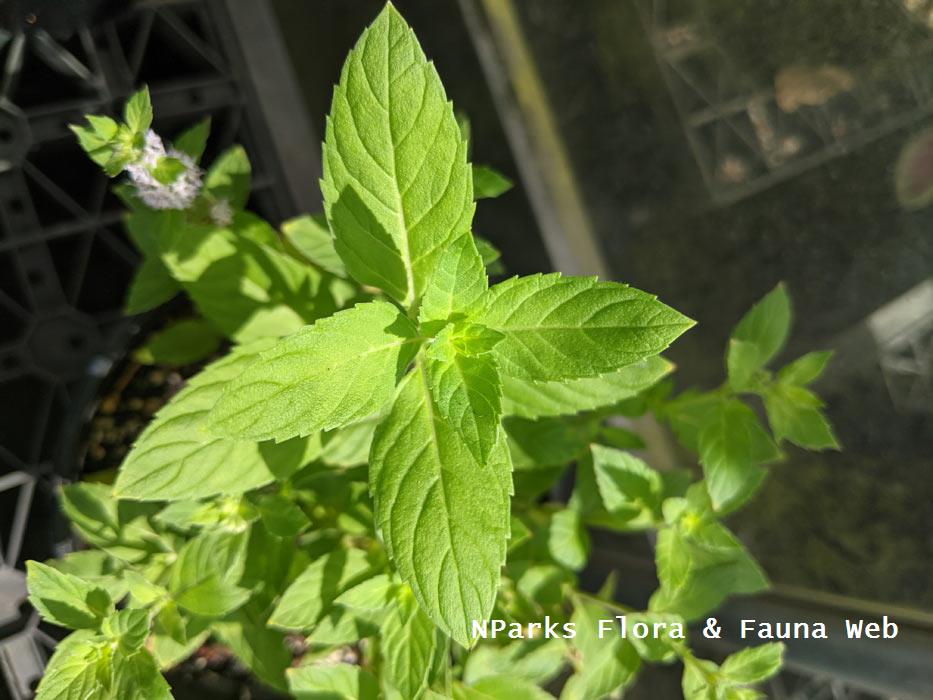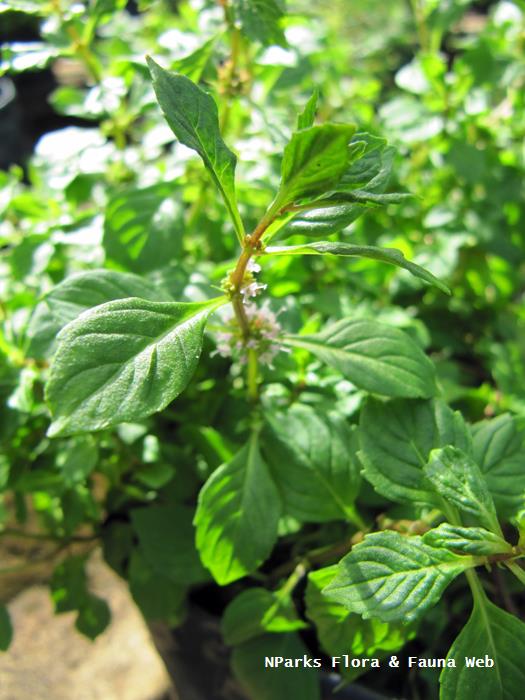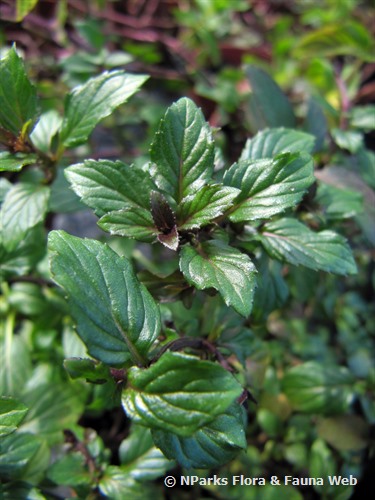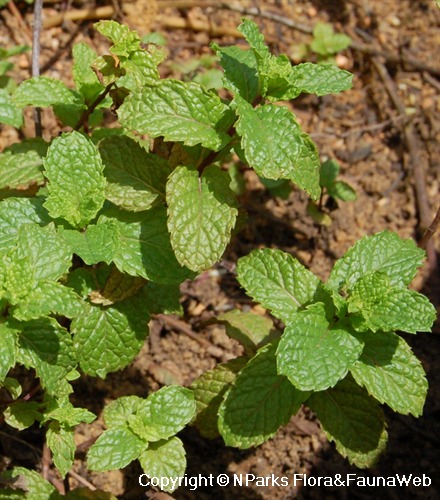
Back
Mentha spicata L.
| Family Name: | Lamiaceae (Labiatae) |
| Synonyms: | Mentha sylvestris, Mentha longifolia var. mollissima, Mentha viridis, Mentha longifolia var. undulata, Mentha cordifolia, Mentha longifolia |
| Common Name: | Spearmint, English Mint, 留兰香 |
Name
Classifications and Characteristics
| Plant Division | Angiosperms (Flowering Seed Plants) (Dicotyledon) |
|---|---|
| Plant Growth Form | Herbaceous Plant |
| Lifespan (in Singapore) | Perennial |
| Mode of Nutrition | Autotrophic |
| Maximum Height | 0.3 m to 1 m |
Biogeography
| Native Distribution | Europe, Asia |
|---|---|
| Native Habitat | Terrestrial (Riverine) |
Description and Ethnobotany
| Growth Form | Perennial herb produced from a creeping rhizome. Has an upright growth habit. |
|---|---|
| Foliage | Leaves light green and ovate to lanceolate with deep veins and serrate leaf margin. Leaves have opposite arrangement and little to no petioles. Leaves are often hairless on both sides, but the lower side may have a few hairs. Rubbing the leaves releases a minty fragrance. |
| Flowers | Flowers (3 mm long) encircle the floral stalk near the tip and are arranged in a spike inflorescence (4 – 10 cm long). Flowers are tubular and 4-lobed. Long stamens extend past the petals. |
| Fruit | Fruits are smooth, ovate nutlets with a hairy apex. Nutlets are small, one-seeded fruits produced when the seed-bearing structure fragments. Each flower produces 4 nutlets. |
| Others - Plant Morphology | Stem: Stems are 4-sided. Propagation: Propagate by division of roots or stem cuttings.Caution: Touching the leaves may irritate the skin for some people. |
| Habitat | Found near the edge of streams or ditches. Also found in meadows and abandoned fields. |
| Cultivation | Space plants 0.9 – 1.2 m apart. Tolerant of many types of soil, but keep soil moist at all times. Ideal soil would have a pH of 5.5 – 7.5 and good drainage. Plants are susceptible to aphids, rust and powdery mildew. Every 3 years, replace plants with new ones. Harvest leaves before or soon after flowering for optimal flavor. After flowering, cut back the plants to promote new growth. |
| Etymology | The genus name “Mentha” comes from a Greek myth about a nymph named “Minthe” (also known as Menthe) who became Pluto’s mistress. Pluto’s jealous wife transformed Minthe into a mint plant. |
| Ethnobotanical Uses | Edible Plant Parts : Edible Leaves Food (Herb or Spice) Others: Food: Leaves are used to flavor teas, desserts, candies, vegetable dishes and sauces. The leaves are commonly used in Indian cuisine. Leaves may also be consumed raw, such as adding them to salads. Medicine: Inhaling the essential oils may help relieve some cold symptoms. Leaves are also used as a medicinal stimulant. It is thought that drinking spearmint tea helps to relieve headaches, fever, and digestive problems. Others: The leaves contain antioxidants that have potential to preserve fresh meat and allow it to be stored longer (Kanatt et al 2007). Leaf extracts have antifungal properties. Singh et al (1994) demonstrated that leaf extracts inhibited the growth of the fungus Fusarium oxysporum f. sp. lentis. The oil may also be used to flavor toothpaste. Lawrence (1993) estimated an annual, worldwide production of 851 tons of spearmint oil, worth US$17 million. |
Landscaping Features
| Desirable Plant Features | Fragrant (Foliage, Flowers) (Time Independent) |
|---|---|
| Landscape Uses | Container Planting |
| Thematic Landscaping | Economic Garden |
| Usage Hazard - Cons Remarks | Touching the leaves may cause skin irritation for some people. |
Fauna, Pollination and Dispersal
| Fauna Pollination Dispersal Associated Fauna | Butterfly-Attracting |
|---|---|
| Pollination Method(s) | Biotic (Fauna) (Insects (Butterfly, Moth)) |
| Seed or Spore Dispersal | Abiotic |
Plant Care and Propagation
| Light Preference | Full Sun, Semi-Shade |
|---|---|
| Water Preference | Moderate Water |
| Plant Growth Rate | Fast |
| Rootzone Tolerance | Easy to Grow, Fertile Loamy Soils, Well-Drained Soils, Poor Infertile Soils, Waterlogged Soils (Drains Site), Shallow Media |
| Maintenance Requirements | Low |
| Propagation Method | Seed, Stem Cutting, Division |
Foliar
| Mature Foliage Colour(s) | Green |
|---|---|
| Mature Foliage Texture(s) | Raised / Sunken Veins, Thin |
| Foliar Type | Simple / Unifoliate |
| Foliar Arrangement Along Stem | Opposite |
| Foliar Shape(s) | Non-Palm Foliage (Ovate, Lanceolate) |
| Foliar Venation | Pinnate / Net |
| Foliar Margin | Serrate / Toothed |
| Foliar Apex - Tip | Acute, Rounded |
| Foliar Base | Rounded / Obtuse |
| Typical Foliar Area | Microphyll ( 2.25cm2 - 20.25 cm2 ) |
Non - Foliar and Storage
| Stem Type & Modification | Herbaceous |
|---|---|
| Root Type | Underground (Tap Root) |
Floral (Angiosperm)
| Flower & Plant Sexuality | Bisexual Flowers |
| Flower Colour(s) | Pink, Purple, White |
|---|---|
| Flower Symmetry | Radial |
| Individual Flower Shape | Tubular |
| Inflorescence Type | Spike |
| Flowering Period | Free-Flowering |
| Flowering Opening Time | Daytime |
Fruit, Seed and Spore
| Mature Fruit Colour(s) | Brown |
|---|---|
| Fruit Classification | Simple Fruit |
| Fruit Type | Indehiscent Dry Fruit , Nut / Nutlet |
Image Repository
Others
| Master ID | 30637 |
|---|---|
| Species ID | 4946 |
| Flora Disclaimer | The information in this website has been compiled from reliable sources, such as reference works on medicinal plants. It is not a substitute for medical advice or treatment and NParks does not purport to provide any medical advice. Readers should always consult his/her physician before using or consuming a plant for medicinal purposes. |

.jpg)


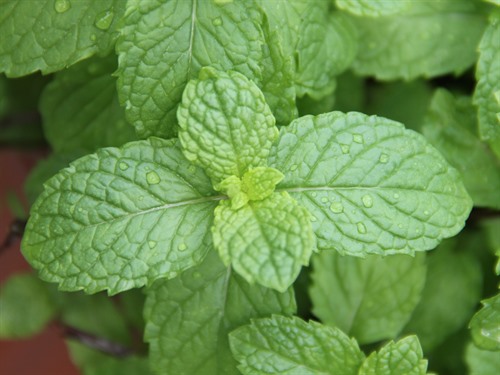
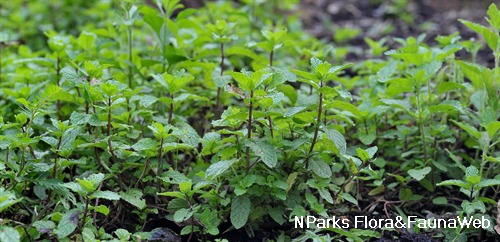
.jpg)
.jpg)
.jpg)
